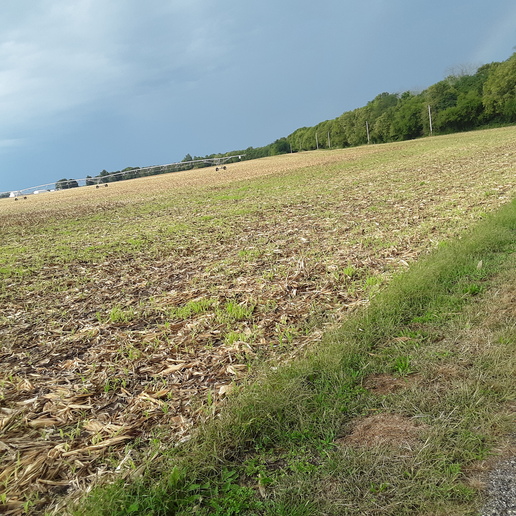You should upgrade or use an alternative browser.
- Thread starter Geo-TH,In
- Start date
MarkB_MI
Well-known Member
- Location
- Motown USA
deeretails
Member
Geo-TH,In
Well-known Member
I haven't seen anyone in Terre Haute chop silage.
They use round bales of hay to feed cows.
I don't know anyone who milks cows either.
I wonder if corn is too valuable to make silage?
Dad chopped the corn that wasn't going to produce a good harvest.
BonaparteSouth
Member
caterpillar guy
Well-known Member
Majorman
Well-known Member
- Location
- Scarning, Norfolk, England
The greatest area of combine loss was from dropped heads at the cutter bar and shelled out grain from the reel. Another area was from trying to get too clean a sample and overloading the returns system leading to a trail of grain from either the sieve pan or the straw walkers depending where the returns were fed back into the machine.
With the advent of straw choppers and spreaders most people do not check grain loss even though they have monitors. Monitors are only as good as the operator who adjusts them. I met many operators who believed that, if he adjusted the monitor to show no grain loss, he was doing a good job no matter how much was going over the back.
BonaparteSouth
Member
fixerupper
Well-known Member
chuck from neb
Member
john in la
Well-known Member
So I looked up a few things.
200 bushel per acre corn at 3.5% loss would be 7 bushels per acre.
Corn has 75,000 to 90,000 kernels per bushel so lets use 82,500.
So you guys are saying a combine in working order is planting 82,500 x 7 = 577,500 kernels of corn per acre.
Seems the combine does a better job of planting corn than the planter does.
And 7 bushels per acre x 1000 acres is a loss of 7000 bushels.
At $5 a bushel thats $35,000
Seems it would pay to have a dealer go threw a combine every year to repair or tune-up the combine.
coonie minnie
Well-known Member
Traditional Farmer
Well-known Member
- Location
- Virginia
coonie minnie
Well-known Member
oldwrencher
Member
fixerupper
Well-known Member
With corn if the ear doesn't shell real easy and the stripper plates are set at the proper distance apart you should see almost no kernals on the ground behind the corn head and only a few broken kernals behind the combine. The corn head pulls the stalk down between the stripper plates very violently, so fast usually the human eye can't see it go down. When the stalk is on the way down the ear hits the stripper plates and being too big to big to make it through the strippers the ear is pulled off the stalk violently again. This might shell some kernals off the butt of the ear. Some of those kernals end up in the combine but some of the kernals go on down to the ground. The corn plants can vary in size and strength across the field. If there is a sandy place in the field the stalks and ears might be smaller in that sand. The ears might go right on down between the stripper plates and end up being ground up in the stalk rolls and sprayed down on the ground. This is why we see more volunteer corn in some areas of the field and no volunteer corn in other areas. If the corn has been blown over by the wind we will see tons of volunteer corn from plants the corn head cannot pick up. Those clumps of volunteer corn in George's picture might be from stalks knocked over by animals at the edge of the field or the corn might have been down in that area or the ear might have dropped off the stalk before the combine went through. The reason we see the volunteer corn growing in this picture is because the stalks were disked and the kernals incorporated into the soil. If the stalks are left alone in the fall we won't see volunteer corn until spring.
Northvale PA
Member
Similar threads
- Replies
- 5
- Views
- 583
We sell tractor parts! We have the parts you need to repair your tractor - the right parts. Our low prices and years of research make us your best choice when you need parts. Shop Online Today.
Copyright © 1997-2024 Yesterday's Tractor Co.
All Rights Reserved. Reproduction of any part of this website, including design and content, without written permission is strictly prohibited. Trade Marks and Trade Names contained and used in this Website are those of others, and are used in this Website in a descriptive sense to refer to the products of others. Use of this Web site constitutes acceptance of our User Agreement and Privacy Policy TRADEMARK DISCLAIMER: Tradenames and Trademarks referred to within Yesterday's Tractor Co. products and within the Yesterday's Tractor Co. websites are the property of their respective trademark holders. None of these trademark holders are affiliated with Yesterday's Tractor Co., our products, or our website nor are we sponsored by them. John Deere and its logos are the registered trademarks of the John Deere Corporation. Agco, Agco Allis, White, Massey Ferguson and their logos are the registered trademarks of AGCO Corporation. Case, Case-IH, Farmall, International Harvester, New Holland and their logos are registered trademarks of CNH Global N.V.
Yesterday's Tractors - Antique Tractor Headquarters
Website Accessibility Policy


